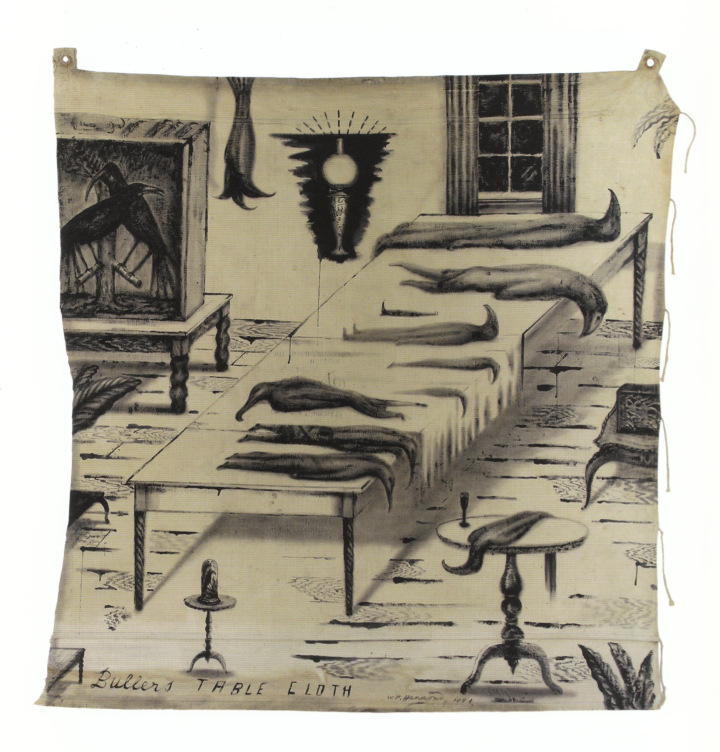Nine Lives, ex. cat. (Auckland: Auckland Art Gallery, 2003).
Bill Hammond’s work has been described as ‘pencil-case art’. This expression deftly recalls the way naughty, smelly boys decorate (or deface) their school pencil cases, exercise books, and bags, proceeding without plan, accumulating noxious motifs, rather than attending to their lessons. In his paintings in the 1980s, Hammond often routinely filled every available cranny of picture space, jumbling perspectives and clashing codes. His extreme and contradictory perspectives and registers displaced the sovereign viewer; finding a stable interpretative frame was impossible. Wired, paranoid, these paintings were junky, punky, and dystopian—juiced up with sadistic speed-freak cartoon violence. Ecstatic, tortured, figures morphed into one another and their environment, into buildings and chattels, mutating with rhyme but without reason. The paintings offered no pastoral idyll or redemptive promised land, but a deregulated incubator world, super-heated, hyperactive with information; a surreal world where categories melted, coagulated, and clotted, and the centre would not hold. Hammond imagined his world as a mixing desk (Mixing Desk 1987), as video game shoot-em-up (Channel Zero 1988), and as an exotic land (Japan 3, 4, 5 1992).
A major shift came after 1989, when Hammond visited the remote Auckland Islands, a veritable bird sanctuary. Inspired, Hammond imagined himself in Old New Zealand, before even the Maori had arrived, and birds were still on top. Returning to New Zealand, he developed a series of bizarre paintings of bird-people, with echoes of ornithological illustration, colonial topological landscape painting, comics, children’s books, history painting, Hieronymus Bosch, Grandville, Max Ernst’s Loplop, and, crucially, Walter Lawry Buller.
Buller was a nineteenth-century Pakeha lawyer-magistrate-ornithologist. As his perennial 1873 bestseller A History of the Birds of New Zealand still provides the standard renderings of our native birds, Buller is popularly linked with a love of things native. However, he believed that the native plants, birds, and people of New Zealand would invariably be displaced by the superior European stock, making New Zealand an antipodean repository of English country life. According to Buller, the Maori were ‘dying out and nothing can save them. Our plain duty as good and compassionate colonists, is to smooth down their dying pillow.’ Buller certainly helped speed the decline of the native-bird population, sponsoring an avian Armageddon, ‘preserving’ birds on a semi-industrial scale: commissioning their collection and delivery to Europe by the crateload to be stuffed. In revisiting Buller in works like Buller’s Table Cloth (1994), Hammond puts considerable spin on the postcolonial thing.
But, while they got everyone talking, it’s hard to pin down the moral upshot of Hammond’s bird paintings. His birds-becoming-people gaze out across the water as though anticipating invasion, or while away hours in the pub drinking, smoking, and playing pool in print shirts. Even in their dark state of nature, they are inscribed with musical notation and copperplate script and play cellos, as if fatalistically looking forward to what will overwhelm them. They are floating signifiers, referring at once to the birds there before the Maori, to the Maori who decimated the bird population, and to the Pakeha who then dealt to the Maori. They can be shown as pathetic holocaust victims or as a brooding, hankering, conspiring criminal gang, just as the paintings lurch from being bent and sadistic to being whimsically pastel.
The bird-people are everyone at once: us and them—villains and victims—rolled into one. Hammond’s trick is brainstorming all the possibilities, while refusing to be our moral guide. Perhaps God is dead and Hammond is the anti-McCahon.
.
[IMAGE: Bill Hammond Buller’s Table Cloth 1994]
